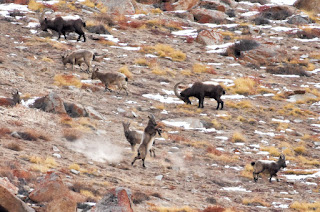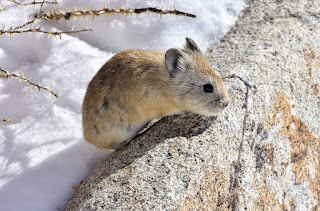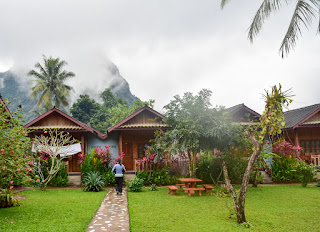Our travels have brought us to Ladakh in far northern India in search of the elusive Snow Leopard. We began our journey in Leh, the capital of Leh district in the Indian state of Jammu and Kashmir, with our naturalist guide, Avijit Sarkhel. At an elevation of 11,562 feet we had to spend a few days here to acclimatize to the high altitude.
A 2-hour drive brought us to Hemis National Park, quite possibly the best place to see Snow Leopards in the wild. A short trek brought to to our campsite in Husing Nala. Along the way we spotted a small herd of Bharal or Blue Sheep quite close to the road. This was a good sign as Blue Sheep are the preferred prey of Snow Leopards. Where there are sheep, the Snow Leopards can't be too far behind.
That evening we explored the valley but the cats remained hidden. The next day we moved up toward the Rumbak Valley. Our guides were surprised at how little snow there was. "Normally all these brown hills you are seeing should be covered in snow" Dorje, one of our local guides commented. This meant that the Blue Sheep and hence the Snow Leopards would stay higher. We had our work cut out for us. We spent 2 days scanning the high ridges of over 15,000 ft from a plateau at the confluence of two valleys. We spotted some flocks of Blue Sheep on the surrounding ridges but no Snow Leopards.
 |
| City of Leh |
A 2-hour drive brought us to Hemis National Park, quite possibly the best place to see Snow Leopards in the wild. A short trek brought to to our campsite in Husing Nala. Along the way we spotted a small herd of Bharal or Blue Sheep quite close to the road. This was a good sign as Blue Sheep are the preferred prey of Snow Leopards. Where there are sheep, the Snow Leopards can't be too far behind.
 |
| Bharal or Blue Sheep |
That evening we explored the valley but the cats remained hidden. The next day we moved up toward the Rumbak Valley. Our guides were surprised at how little snow there was. "Normally all these brown hills you are seeing should be covered in snow" Dorje, one of our local guides commented. This meant that the Blue Sheep and hence the Snow Leopards would stay higher. We had our work cut out for us. We spent 2 days scanning the high ridges of over 15,000 ft from a plateau at the confluence of two valleys. We spotted some flocks of Blue Sheep on the surrounding ridges but no Snow Leopards.
 |
| Scanning for Snow Leopards |
We made the decision to move up higher and stay in the tiny village of Rumbak. It not only gave us a better chance to find the Snow Leopards but allowed us to spend time with the local people. We were the guests of Phunchock and her family at her homestay.
 |
| Phunchok Next to a Chulha Stove |
We were here for just 3 nights but the people who live here have to survive the brutally cold winters. Homes are heated by small stoves burning yak dung or willow branches. We were fortunate to have one of these stoves in our room to keep us warm.
 |
| Peggy in our Room |
The fields lay fallow during the winter and the livestock have to forage on the meager vegetation or eat fodder grown during the summer and is now being stored on the roofs of most homes.
 |
| Rumbak Village |
On our third day we decided to head up the Rumbak Valley in search of the hard-to-find felines. Suddenly Dorje Tsewang, our assistant local guide, shouts "Snow Leopard!" Somehow he had spotted a Snow Leopard sitting on the top of a ridge about a mile and a half away!
 |
| Can you Spot the Snow Leopard? |
Through our binoculars and a spotting scope we could get a good view of the cat. Marc was able to get a reasonably good photo with his new 500mm lens with an 1.4x teleconverter. Hauling all this heavy camera equipment finally paid off.
We watched the leopard for about 15 minutes before he disappeared behind the ridge. Oh well, at least we had seen a Snow Leopard! We sat and waited for him to return but he didn't. There were flocks of Blue Sheep on the ridge below. Had he been following them? To keep warm we walked further up the valley before heading back to the spot from which we had seen the Snow Leopard. Jigmat and Tsering, two of our local staff, had just arrived with our lunch. They didn't believe we had seen a Snow Leopard. Just as we were finished eating, the Snow Leopard returned! It was about a hour and 40 minutes since we had last seen him. He walked along the ridge, stretched and began stalking the blue sheep.
 |
| The Snow Leopard Returns! |
We watched in anticipation as two groups of Blue Sheep moved closer to his location. One group appeared to be a bachelor herd. They were oblivious to the Snow Leopard's presence, sparring and even dominance mounting.
 |
| Blue Sheep Sparring |
Surely we would witness a kill... The Snow Leopard was in the perfect position and the Blue Sheep were unaware. "Come on cat make your move!" we all implored.
 |
| "Come on Make Your Move!" |
Suddenly, all the Blue Sheep ran over the ridge and disappeared. Had they detected the cat? Had the cat made a kill on the other side of the ridge out of our view? The Dorjes went down valley to see if they could see the Snow Leopard again. We waited for awhile then followed them. They had briefly seen the leopard again so apparently he hadn't made a kill. Oh well, it was a thrilling encounter just the same!
The next morning Dorje knocked on our door to tell us a pair of Tibetan Wolves had been spotted on the ridge across the valley. We threw on our clothes and just outside our door Dorje had set up the spotting scope so we could get a good look at the couple.
Today we hiked to Yurutse Village to search for Lynx or maybe to see another Snow Leopard. We headed down to the river valley where we saw lots of wolf tracks but no wolves. Dorje spotted fresh Snow Leopard (presumably female) urine on a rock and there were also fresh Snow Leopard tracks on the frozen river.
 |
| Tibetan Wolves |
Today we hiked to Yurutse Village to search for Lynx or maybe to see another Snow Leopard. We headed down to the river valley where we saw lots of wolf tracks but no wolves. Dorje spotted fresh Snow Leopard (presumably female) urine on a rock and there were also fresh Snow Leopard tracks on the frozen river.
 |
| Snow Leopard Tracks |
We headed up a side valley toward the village. It was a glorious day with bright sunshine, snow covered peaks and cobalt blue skies. The views were magnificent.
Dorje was constantly scanning but did not spot any wildlife. We arrived at the village which was only one very large home built a hundred years ago in the traditional Tibetan style. Only a father and son were currently living there.
We sat and scanned. A large flock of close to 50 Blue Sheep were grazing low down on a ridge on the opposite side of the river.
 |
| Yurutse Village |
We sat and scanned. A large flock of close to 50 Blue Sheep were grazing low down on a ridge on the opposite side of the river.
 |
| Large Flock of Blue Sheep |
The following day we left Rumbak. On the hike back to the car park we were hoping to see one more of these magnificent cats but they remained elusive. We drove to our next site, Ulley Village, where Snow Leopard sightings have been good in recent years. Ulley is also a great place to see Asiatic Ibex. The following morning a herd was spotted high above the village. We drove then hiked up to get a closer look. We hid behind some rocks to watch some magnificent males spar. They were butting heads with the full force of their weight. Marc actually captured a male on two legs!
 |
| Sparring Asiatic Ibex |
The next day we drove to Hemis-Shukpachen where a pack of Tibetan Wolves had recently been sighted. We didn't find the wolves but spotted a big flock of Ladakh Urials on a ridge below the village.
 |
| Male Ladakh Urials |
That night and into the following day it snowed! We were hoping that the new snowfall would bring the Ibex and Urials lower and that the Snow Leopards would follow but sadly this did not happen. In searching for the cats we came across other wildlife in the area. A cute Large-eared Pika scurried between the rocks stopping briefly for Marc to get a photo!
 |
| Large-eared Pika |
All too soon it was time to leave Ulley and return to Leh. The freshly fallen snow made for a spectacular return drive.
 |
| View on the Drive Back to Leh |
The following morning we had an equally stunning flight over the Great Himalaya Range. From this great height we got a better picture of the domain of the Snow Leopard.
 |
| Great Himalaya Range |
With so many mountains, valleys, ridges and rocky outcrops to hide in it's no wonder that finding these cagey cats is so difficult. At least now we had seen one of these remarkable felines and know first hand that ghosts do exist!
We hope all is well back home.
Peggy and Marc
A very sincere thanks to our local guides Dorje Skiu and Dorje Tsewang for their constant scanning and spotting some of Ladakh's elusive wildlife!
 |
| The Dorjes Scanning |




















































